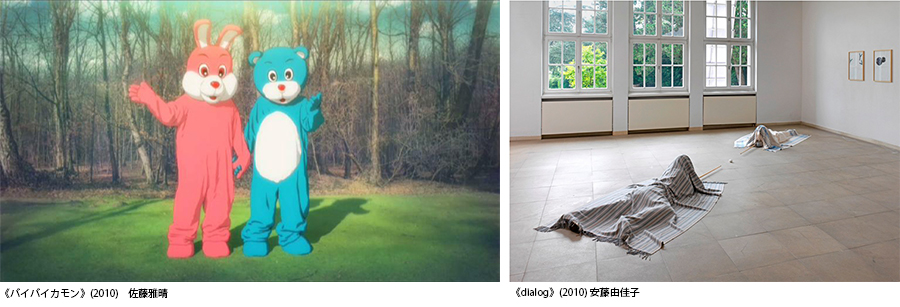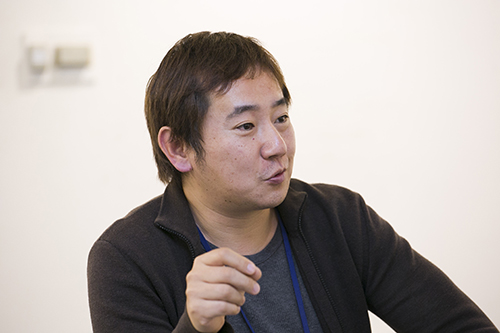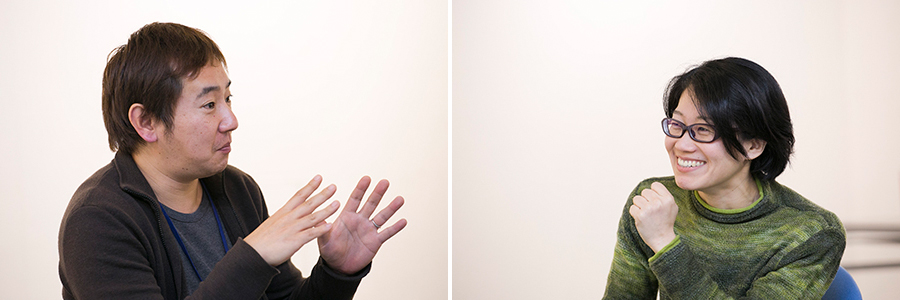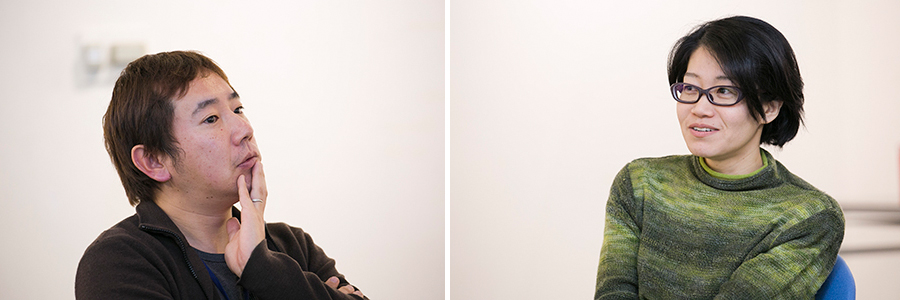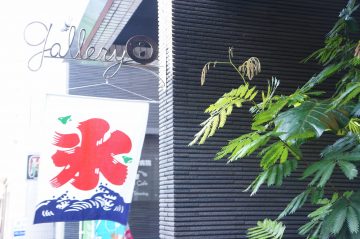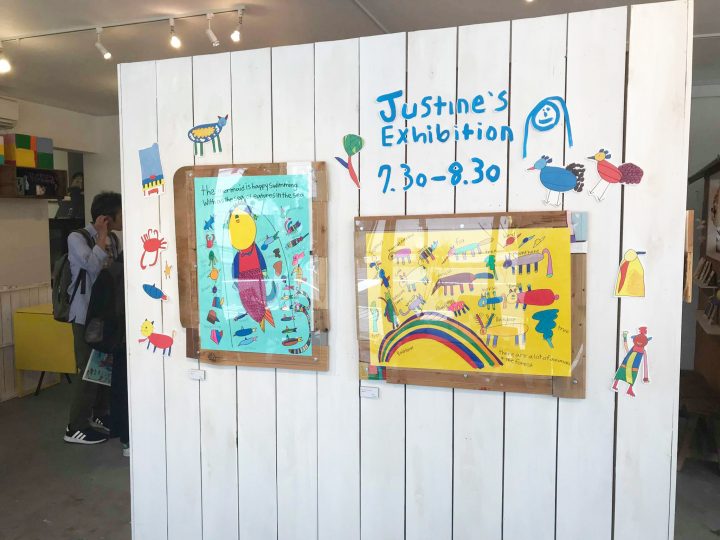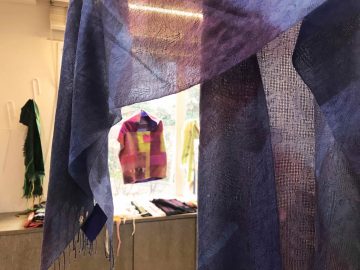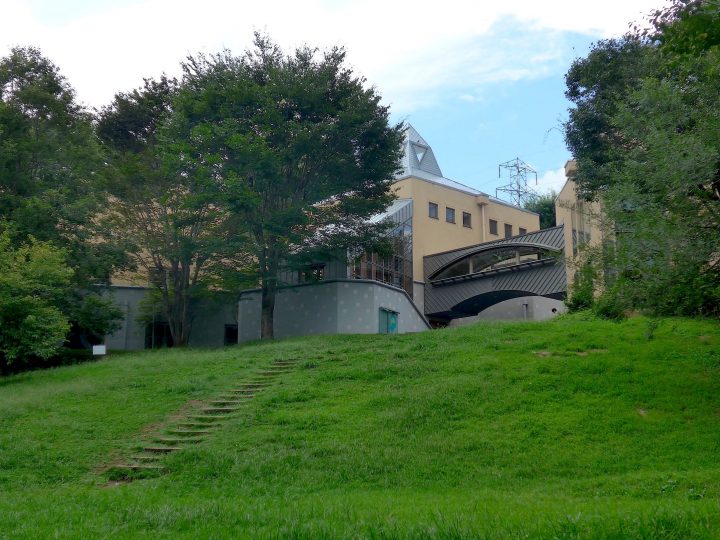[Daily Life/Off the Record Exhibition Linked Project] Yukako Ando x Masaharu Sato Cross Interview
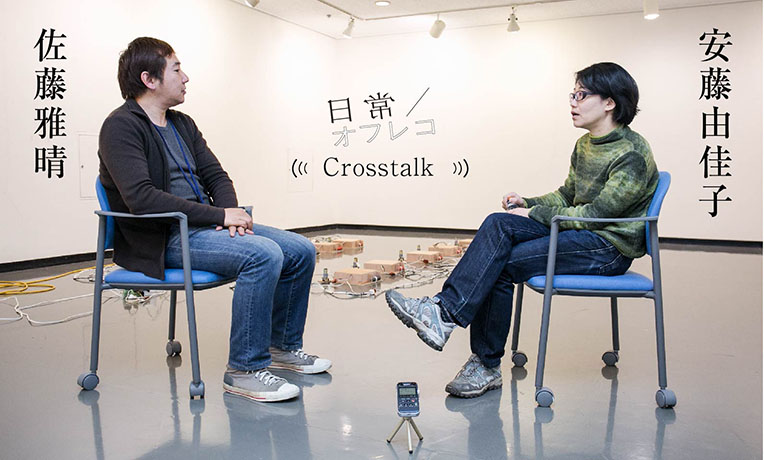
A cross-interview with artists participating in the exhibition "Daily Life/Off the Record" held at KAAT Kanagawa Arts Theatre Middle Studio from Saturday, January 11th to Thursday, January 30th, 2014.
This time, we asked Yukako Ando, an art artist who skillfully uses everyday materials such as newspapers and calendars to create conceptual works, and Masaharu Sato, who presents mysterious stories in animation, about each other's work and things that they are curious about, using the exhibition as a starting point.
The two of them are both graduates of the Dusseldorf Art Academy in Germany and are old friends. I'm looking forward to hearing what they have to say.
■Question from Yukako Ando to Masaharu Sato
Ando Yukako (hereinafter Ando): We met in the 90s, right?
Masaharu Sato (hereinafter Sato): Around 1998.
Ando: At that time, Mr. Sato was a graduate student at the Tokyo University of the Arts and I was a student at the Academy of Arts in Düsseldorf, and we met for the first time as part of a cultural exchange between the schools.
From what I imagine, the style of your current animation work and the style you had when you first encountered it are completely different, but I think there may be some commonalities in terms of concepts. How did you develop into your current animation work?
Sato: First, when I arrived in Germany, I made a stop-motion animation work drawn with charcoal on paper, and that was where I started making animation. However, before coming to Germany, I had been making installation works all the way through my undergraduate and graduate studies.
Ando: Yes, I had the impression that you were working outdoors with nature and buildings. What kind of story was your first charcoal animation work?
Sato: I came to Germany from Japan with just one suitcase, and the place I was living in was a room of about four and a half tatami mats, but when I thought about what to do there, the scenery and towns of Germany were so fresh that I wanted to take pictures of the town and make them move. I created an animation that crossed the scenery of the town with the dreams I had while sleeping. Also, I started using a computer around 2004, and since then I have been working at home without needing an atelier.
Ando: I think that the work environment changed in that way, and the process of going outside by working in a room was necessary. At that time, I thought that I had never seen anyone working at school.
Sato: The big shared studio at the university is somehow scary... Whenever I leave things or tools there, they always disappear (laughs).
Ando: Yes, if you don't come to the workshop every day, it will disappear, and if you don't come to the workshop every day, the tools will disappear too. That's strange, isn't it?
Sato: I don't even understand the discussion (laughs)
Ando: Discussions are scary, aren't they? But when Mr. Sato came to that class, the atmosphere was a little more relaxed. In the past, it was a class where everyone worked together to hammer out concepts, which was educational in both good and bad ways. When I first joined the class, it was a place where people were criticized. (laughs)
Sato: (laughs) Because of that, I started to stay at home for two years, and when I finally submitted my work, my teacher called it a "catastrophe" (laughs).
Ando: (laughs)! What's the content?! Can you explain a bit about what kind of work it is?
Sato: The city of Dusseldorf is drawn in great detail with charcoal on a piece of paper about three meters long, and then my severed head appears on it. I erase it with an eraser and draw it again, filming the process stop-motion, and at the end it disappears, leaving a crater in the city.
Ando: Was Sato-san smiling or...?
Sato: I was yawning (laughs)
Ando: (laughs)! Was that the last class you took with the teacher?
Sato: Right (laughs). In the end, when I tried to become a regular student, my teacher didn't give me permission and told me to hurry up and become a writer. When my visa expired and I was wondering whether to go back to Japan or stay in Germany, I was talking about marrying my current wife, so I decided to stay in Germany for another year until she graduated.
So I got a job at an izakaya run by a Japanese person, and for about eight years I worked in the izakaya kitchen skewering yakitori. (Laughs) Because I was skewering yakitori every day, my hopes of becoming an artist started to crumble.
Ando: My true self came out. Perhaps what I felt in the izakaya kitchen was condensed when it was time for me to create, and is reflected in my current surreal works?
Sato: Yes... There was something a little creepy about it. But my driving force was anger, resentment, and dissatisfaction, so maybe it was actually nourishment for me. So while I was in Germany, from 2004 to 2007, I spent about four years making an animation of about 10 minutes. I wanted to be an animator.
Ando: How does it feel to be an animator and to be an artist?
Sato: I had no pride, so I didn't think I could become an artist.
Ando: I didn't have that feeling from the beginning. I never really made it clear to myself that I wanted to be an artist or anything like that.
Sato: I see.
Ando: For some reason, that's the kind of environment I feel comfortable in, and I'm an extension of that. I often hear people around me say things like, "I want to study in Germany," or "I want to be a German artist," but I had no idea what that meant. (laughs)
Sato: I see. Also, isn't it "Künstler" in Germany? The word itself doesn't mean "artist". That was really good. When I opened a bank account in Japan, if I wrote "I'm an artist" I would get asked "What do you sing?" (laughs) In Germany, Künstler is dubbed to mean "something new", so the reactions of the people around me are natural.
Ando: There are no barriers. They are more and more interested and ask questions. It's really fun when an old lady comes and asks, "What is this?"
Sato: That's right. In that respect, I think that in Japan, I am seen as something special, and my family and relatives ask me, "How are you going to survive?" On the other hand, when I'm featured in the newspaper, they suddenly start praising me. (laughs) When I was in Germany, I felt that artists are a natural part of society, whereas in Japan, they are different from other members of society.
Ando: It's more of an outsider position. Germany has a position in society, so they know that and they're sending out messages from there.
■Question from Masaharu Sato to Yukako Ando
Sato: Next, I would like to ask a question. Mr. Ando, I believe you have had the experience of curating a show for three artists at the request of a curator. Could you tell us about that experience?
Ando: This was at Kunstraum, a space owned by the Düsseldorf Cultural Affairs Bureau. Of course, the curator is supposed to curate the exhibition himself, but at that time, in a slightly unusual way, the curator picked five artists, and those five artists then chose three artists each to curate their own exhibition. I was chosen as one of the five artists.
In other words, there were 15 artists exhibiting in the exhibition. There were 5 curators and artists. Because it was a big exhibition overall, we shortened the exhibition period very much and rotated it like a relay.
Sato: Before you were approached by that original curator, had you ever exhibited a work as part of that person's project?
Ando: I had an exhibition called "FAULWERK" there in 2001. It was a two-person exhibition.
Sato: When you were asked to be the curator, you must have wondered why they chose you?
Ando: That's right. In fact, I asked him after the exhibition I curated started, and he said, "I thought you would know a lot about the scene, and that you would be able to curate an exhibition that is unique to you, with a different perspective and angle than Germans." I thought I could do it from my perspective, but I don't know much about it... (laughs)
Sato: It's not like artists go to see exhibitions like curators do. They basically just create.
Ando: What was interesting was that after I got the job of curating, I looked at the works with a different eye. It was like I was a hunter (laughs).
I worked as a curator for this exhibition twice, in 2011 and 2012. The first time in 2011, it wasn't a visual project, but rather a very conceptual one, where I decided on the type of thing I wanted to do and gathered artists together.
For example, it would be good if the three artists were from different countries, lived in different places, and were involved in different fields. And we let the artists freely create new works as an extension of what they had been doing up until now.
However, the second time, I felt like I wanted to pick out works more like a curator, and I arranged the works more intuitively, both visually and thematically, according to my own image of the exhibition.
Sato: I see. So the first time you tried to fulfill your own role as a curator and did it completely as a curator, and the second time you tried to emphasize your role as an artist.
Ando: They're both the same thing. Maybe it's just a matter of how you hold the reins.
Sato: In the end, which was better, the first time or the second time?
Ando: Both had their own interesting parts. It may have seemed like they were curated by different people. But, you know, it's only possible because it's been two times, I'm not in a position to plan things, I'm the one who makes things.
I found it really interesting that curators are always thinking ahead, looking at various things and storing them in various drawers.
■About the works on display this time

"Datemaki" (2013) by Masaharu Sato
Ando: I have only seen photos of the work "Datemaki" that Sato will be exhibiting this time, and have not yet seen the actual work, but in that state, I am curious about two things: "Why Datemaki?" and "Why a factory in Fukushima?"
Sato: The work "Datemaki" that I will be exhibiting at the Off the Record Exhibition is an animation of something that we see often but don't know how it is processed, taken from an off the record (something that is not usually visible or remembered). I actually interviewed the process of making Datemaki at a kamaboko factory that was affected by the Great East Japan Earthquake.
This work was made up of a combination of various factors: firstly, I was diagnosed with cancer in the summer of 2010, then the earthquake in 2011, and finally my wife collapsed from a subarachnoid hemorrhage in 2013. My wife and I are both doing well now, but when she collapsed the hospital told me to prepare myself, and I was really scared. But somehow she managed to regain her life, and when I thought about death, family, the earthquake, and many other things, I naturally felt like I wanted to go to the disaster-stricken areas, which I had not been able to visit because I was afraid the cancer would recur.
So I found out about this kamaboko factory... Apparently the entire factory was once washed away by a tsunami, but was rebuilt in the same place. The wife of the company's president was a director and came from outside the area, so she was afraid of the ocean, and when the tsunami came, she told all the employees to run to higher ground. Thanks to that, the employees were saved, but on the other hand, local people went to see the ocean and were killed.
The work is made up of such stories and various other things that are directly and indirectly related to each other, all fitted together like a puzzle.
Ando: I'm looking forward to seeing it at the venue!
* Kamaboko factory { Marumata Kamaboko Manufacturing Co., Ltd. http://marumatakamaboko.com/ }
Sato: Regarding the door piece that you will be exhibiting, the first thing I would like to ask is whether you came up with the idea for it after you were asked to exhibit at this Off the Record exhibition, or whether you had been planning to make it for some time.
Ando: The title of the door work is "# (Unit) 29", which means the number of the apartment in a foreign country, so you would say "I live in #3". That "#29" is the title. When I first heard about it, I heard that it would be an exhibition at the Prefectural Hall Gallery, so I was thinking of something completely different, but when I heard that the Prefectural Hall Gallery was going to be renovated and moved to KAAT, I went to check it out.
I usually exhibit in everyday spaces such as white cubes or outdoors, so to be honest, I thought, "Wow, what should I do?" I have never chosen an exhibition venue like a so-called black box, where the surroundings are dark and the subject is illuminated, such as a theater venue.
This was the complete opposite of my approach, so I was a little confused, but after being shown various mechanisms, I realised that one of the features of it being a theatre is that things can be hung from the ceiling as well.
While I was thinking about how I could use it, the image of a door I had before was combined with the theater space of KAAT. So, #29 was inspired by the venue. Rather than a real door, I wanted to create a more stage-like installation, which is a concept unique to this space.
Sato: Oh, I see.
Ando: There is a viewer and a viewer, and I was a bit interested in that kind of directionality. When exhibiting the door, I thought it might be okay to change the direction and have it visible when lying on its back on the ceiling. At first, it was an installation where the door was opened by gravity, but I thought it would be interesting to open and close it while it was being displayed, so I had someone make a mechanism so that it would open and close randomly. In my mind, I had an image of an invisible man opening the door from the other side and peeking in here.
Sato: When I saw Ando's plan, I thought it was close to the image of the movie "Cube". There is a square room with doors on all sides. The characters can go anywhere inside the cube.
Ando: Wow, I don't know (laughs). The work is made up of 24 almost life-size doors measuring 3 x 8, which are hung from the ceiling, and they are not at a height that the audience can reach, but are made to feel like doors that are out of reach.
Sato: I see. I'm looking forward to seeing the amazing doors this time!
Device for doors
